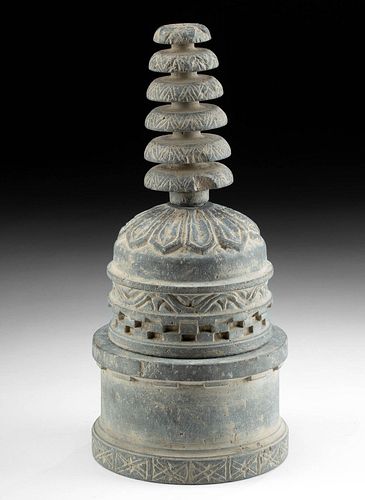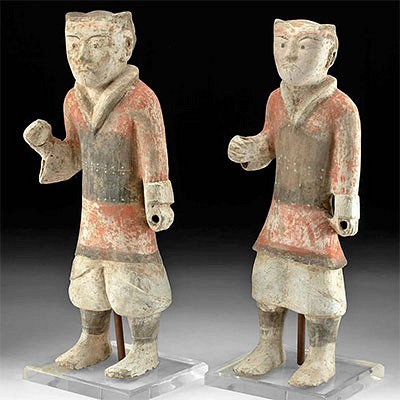2nd C. Gandharan Schist Reliquary Stupa Model
Lot 51a
About Seller
Artemis Fine Arts
686 S Taylor Ave, Ste 106
Louisville, CO 80027
United States
Selling antiquities, ancient and ethnographic art online since 1993, Artemis Gallery specializes in Classical Antiquities (Egyptian, Greek, Roman, Near Eastern), Asian, Pre-Columbian, African / Tribal / Oceanographic art. Our extensive inventory includes pottery, stone, metal, wood, glass and textil...Read more
Categories
Estimate:
$3,500 - $5,000
Absentee vs Live bid
Two ways to bid:
- Leave a max absentee bid and the platform will bid on your behalf up to your maximum bid during the live auction.
- Bid live during the auction and your bids will be submitted real-time to the auctioneer.
Bid Increments
| Price | Bid Increment |
|---|---|
| $0 | $25 |
| $300 | $50 |
| $1,000 | $100 |
| $2,000 | $250 |
| $5,000 | $500 |
| $10,000 | $1,000 |
| $20,000 | $2,500 |
| $50,000 | $5,000 |
| $100,000 | $10,000 |
| $200,000 | $20,000 |
About Auction
By Artemis Fine Arts
May 25, 2023
Set Reminder
2023-05-25 10:00:00
2023-05-25 10:00:00
America/New_York
Bidsquare
Bidsquare : ON-SALE! Antiquities, Pre-Columbian, Ethno, Fine Art
https://www.bidsquare.com/auctions/artemis-gallery/on-sale-antiquities-pre-columbian-ethno-fine-art-12860
ON-SALE Antiquities, Pre-Columbian, Ethno, More! Artemis Fine Arts info@artemisgallery.com
ON-SALE Antiquities, Pre-Columbian, Ethno, More! Artemis Fine Arts info@artemisgallery.com
- Lot Description
**First Time At Auction**
Central Asia, Pakistan / Afghanistan, ancient region of Gandhara, ca. 2nd to 3rd century CE. A model of a Buddhist stupa reliquary, finely carved from grey schist in 3 sections: a cylindrical drum shaped base, a domed midsection, and capped with a finial resembling a spired pagoda - each piece fitting together via tenons and sockets. The surfaces are finely etched and deeply carved with friezes- geometric and linear motifs, and on the domed middle, lotus petals. The form of the stupa is also intended to echo the shape of the crowned Buddha sitting upon a throne, and model stupas were used by Buddhists as devotional items for storing relics or as votive offerings for shrines and temples. Note that the architecture of this miniature - especially the dentilled entablature - is very reminiscent of Greek temples! Size: 5" Diameter x 11.25" H (12.7 cm x 28.6 cm)
The Gandharan Empire made itself wealthy in part by controlling lucrative trade along the mountain passes between China in the East and the Near East and Mediterranean in the West; a great deal of this wealth went into local patronage of artisans and art. In the first century CE, Buddhism became fashionable amongst Gandharan elites, and the art produced at this time also reflects the conquest of Alexander the Great and the introduction of styles from all sides, blended into a uniquely Gandharan tradition. Alexander the Great conquered Gandhara in 330 BCE and with the help of the Indo-Greek kings introduced classical traditions that would influence Gandharan art and architecture for the following seven centuries.
For a similar example of this type, please see the Metropolitan Museum of Arts website, accession number: 1987.142.43a-c.
According to the Metropolitan Museum of Art's Heilbrunn Timeline, "Stupas, the earliest Buddhist monuments preserved in India, began as solid hemispherical domes that marked the remains of a great leader or teacher. They were incorporated into early Buddhist art as symbols of the continuing presence of Shakyamuni Buddha after his parinirvana (final transcendence), and as reminders of the path he defined for his followers. Buddhism carried the stupa throughout Asia, where it was interpreted in many forms, including the domed chortens of Tibet and the spired pagodas of China, Korea, and Japan."
PLEASE NOTE: Due to recent increases of shipments being seized by Australian & German customs (even for items with pre-UNESCO provenance), we will no longer ship most antiquities and ancient Chinese art to Australia & Germany. For categories of items that are acceptable to ship to Australia or Germany, please contact us directly or work with your local customs brokerage firm.
Provenance: private Vero Beach, Florida, USA collection, acquired before 2003; ex-English collection, acquired 1960s.
All items legal to buy/sell under U.S. Statute covering cultural patrimony Code 2600, CHAPTER 14, and are guaranteed to be as described or your money back.
A Certificate of Authenticity will accompany all winning bids.
We ship worldwide and handle all shipping in-house for your convenience.
#177343Finial is repaired with break line encircling midsection under a disc and doesn’t affect overall presentation. Old loss to finial discs and chips, and slightly loose in socket. Chips and nicks to mid and base sections, otherwise intact without repairs. Mineral and earthen encrustations throughout. Overall good condition.Condition
- Shipping Info
-
All shipping is handled in-house for your convenience. Your invoice from Artemis Gallery will include shipping calculation instructions. If in doubt, please inquire BEFORE bidding for estimated shipping costs for individual items.
-
- Buyer's Premium



 EUR
EUR CAD
CAD AUD
AUD GBP
GBP MXN
MXN HKD
HKD CNY
CNY MYR
MYR SEK
SEK SGD
SGD CHF
CHF THB
THB














